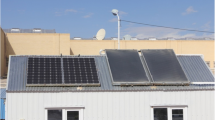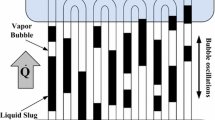Abstract
This research study presents an investigation on the behavior of a Pulsating Heat Pipe Flat-Plate Solar Collector (PHPFPSC) by artificial neural network method and an optimization of the parameters of the collector by genetic algorithm. In this study, several experiments were performed to study the effects of various evaporator lengths, filling ratios, inclination angles, solar radiation, and input chilled water temperature between 9:00 A.M. to 5:00 P.M., and the output temperature of the water tank, which was the output of the system, was also measured. According to the input and output information, multilayer perceptron neural network was trained and used to predict the behavior of the system. A two-layer neural network with a unipolar sigmoid activation function and a 6-20-1 structure was obtained as the network with the highest performance. The trained network was validated with experimental data and used to evaluate the objective function to maximize the thermal efficiency of the system. Also, a continuous genetic algorithm was developed to optimize the system efficiency. An initial population size of 700 and a mutation rate of 4 % were obtained as the best values. Furthermore, at the evaporator length of 1.08, filling ratio of 56.94 %, and inclination angle of 25.01, the maximum thermal efficiency of the system was 61.4 %. The effect of the input water temperature of the water tank on the optimal values of optimization variables was examined. The results indicated that an increase in the temperature of the input water of the water tank leads to a decrease in the thermal efficiency of the system. A comparison of the results of this study with previous research indicates that the use of heat pipes in solar collectors can increase the efficiency of solar collectors up to 4 %. According to the results, the use of neural networks, as an input–output model, is a proper way to predict the complicated behavior of these systems. Also, genetic algorithm is an efficient method for solving non-linear optimization problems.















Similar content being viewed by others
Abbreviations
- A :
-
Area (m2), collector legend
- B :
-
Collector legend
- BPAF:
-
Bipolar activation function
- C :
-
Collector legend, cost
- CR:
-
Filling ratio
- E :
-
Neural network error
- G :
-
Gene
- I :
-
Total solar radiation (W/m2K)
- L :
-
Length (m)
- M :
-
Parent number
- N :
-
Neuron number/number
- NH:
-
Number of neurons in hidden layer
- offs:
-
Offspring
- P :
-
Probability
- Par:
-
Parent
- PHP:
-
Pulsating heat pipe
- Q :
-
Heat (kW)
- RMSD:
-
Root mean square deviation
- T :
-
Temperature (K)
- U :
-
NN Weights between inputs and hidden layer
- UPAF:
-
Unipolar activation function
- V :
-
NN Weights between hidden layer and output layer
- W :
-
Water
- h :
-
Hidden layer in neural network
- i :
-
Epoch counter
- j :
-
Time interval counter
- k :
-
Number of neurons in hidden layer of NN
- l :
-
Number of inputs of NN
- m :
-
Counter
- n :
-
Counter
- t :
-
Time interval
- \(\alpha\) :
-
Activation function parameter
- \(\beta\) :
-
Random number between 0 and 1
- \(\gamma\) :
-
Random number between 1, 2, and 3
- \(\theta\) :
-
Inclination angle of the solar collector
- \(\omega\) :
-
Random number between 0 and 1
- \(\lambda\) :
-
Training rate
- \(\tau\) :
-
Control parameter in simulated annealing
- \(\psi\) :
-
Angle between the direct radiation and normal vector of the collector
- NN:
-
Neural network
- PHPFPSC:
-
Pulsating heat pipe flat-plate solar collector
- c :
-
Solar collector
- Co:
-
Cumulative
- par:
-
Parent
- Tr:
-
Training epoch for the neural network
- ev:
-
Evaporator
- good:
-
Good population
References
Abbasi Godarzi A, Jalilian M, Samini J, Jokar A, Vesaghi MA (2013) Design of a PCM storage system for a solar absorption chiller based on exergoeconomic analysis and genetic algorithm. Int J Refrig 36:88–101
Arab M, Soltanieh M, Shafii MB (2012) Experimental investigation of extra-long pulsating heat pipe application in solar water heaters. Exp Therm Fluid Sci 42:6–15
Azad E (2012) Assessment of three types of heat pipe solar collectors. Renew Sustain Energy Rev 16:2833–2838
Beale R, Jackson T (1990) Neural computing—an introduction. Taylor & Francis, London
Charoensawan P, Terdtoon P (2008) Thermal performance of horizontal closed-loop oscillating heat pipes. Appl Therm Eng 28:460–466
Charoensawan P, Khandekar S, Groll M, Terdtoon P (2003a) Closed loop pulsating heat pipes. Appl Therm Eng 23:2009–2020
Charoensawan P, Khandekar S, Groll M, Terdtoon P (2003b) Closed loop pulsating heat pipes. Part A: parametric experimental investigations. Appl Therm Eng 23:2009–2020
Duffie JA, Beckman WA (2006) Solar engineering of thermal processes. Wiley, New York
Esen M, Esen H (2005) Experimental investigation of a two-phase closed thermosyphon solar water heater. Sol Energy 79:459–468
Facão J, Varga S, Oliveira AC (2004) Evaluation of the use of artificial neural networks for the simulation of hybrid solar collectors. Int J Green Energy 1:337–352
Haupt RL, Haupt SE (1998) Practical genetic algorithms. Wiley, New York
Holman JP (2007) Experimental methods for engineers, 7th edn. McGraw-Hill, New York
Kargar Sharif Abad H, Ghiasi M, Jahangiri Mamouri S, Shafii MB (2013a) A novel integrated solar desalination system with a pulsating heat pipe. Desalination 311:206–210
Kargar Sharif Abad H, Mamouri SJ, Shafii MB, Rahni MT (2013b) Experimental investigation of the effect of using closed-loop pulsating heat pipe on the performance of a flat plate solar collector. J Renew Sustain Energy 5(013106–1):013106–013112
Katpradit T, Wongratanaphisan T, Terdtoon P, Kamonpet P, Polchai A, Akbarzadeh A (2005) Correlation to predict heat transfer characteristics of a closed end oscillating heat pipe at critical state. Appl Therm Eng 25:2138–2151
Khandekar S, Cui X, Groll M (2002) Thermal performance modeling of pulsating heat pipes by artificial neural network. 12th International Heat Pipe Conference Moscow-Kostroma-Moscow, pp 215–219
Latha A, Reddy KVK, Rao JCS, Raju AVSR (2010) Performance analysis on modeling of loop heat pipes using artificial neural networks. Indian J Sci Technol 3:463–467
Lee YW, Chang TL (2009) Application of NARX neural networks in thermal dynamics identification of a pulsating heat pipe. Energy Convers Manag 50:1069–1078
Lin Y-H, Kang SW, Chen H-L (2008) Effect of silver nano-fluid on pulsating heat pipe thermal performance. Appl Therm Eng 28:1312–1317
Mellit A, Kalogirou SA, Drif M (2010) Application of neural networks and genetic algorithms for sizing of photovoltaic systems. Renew Energy 35:2881–2893
Riffat SB, Zhao X, Doherty PS (2005) Developing a theoretical model to investigate thermal performance of a thin membrane heat-pipe solar collector. Appl Therm Eng 25:899–915
Rittidech S, Terdtoon P, Murakami M, Kamonpet P, Jompakdee W (2003) Correlation to predict heat transfer characteristics of a closed-end oscillating heat pipe at normal operating condition. Appl Therm Eng 23:497–510
Rittidech S, Pipatpaiboon N, Terdtoon P (2007) Heat-transfer characteristics of a closed-loop oscillating heat-pipe with check valves. Appl Energy 84:565–577
Rittidech S, Donmaung A, Kumsombut K (2009) Experimental study of the performance of a circular tube solar collector with closed-loop oscillating heat-pipe with check valve (CLOHP/CV). Renew Energy 34:2234–2238
Sánchez-Bautista A, Santibañez-Aguilar J, Ponce-Ortega J, Nápoles-Rivera F, Serna-González M, El-Halwagi M (2015) Optimal design of domestic water-heating solar systems. Clean Technol Environ Policy 17:637–656
Shafii MB, Faghri A, Zhang Y (2001) Thermal modeling of unlooped and looped pulsating heat pipes. J Heat Transfer 123:1159–1172
Shafii MB, Arabnejad S, Saboohi Y, Jamshidi H (2010) Experimental investigation of pulsating heat pipes and a proposed correlation. Heat Transfer Eng 31:854–861
Sivaraman B, Mohan NK (2007) Analysis of heat pipe solar collector using artificial neural network. J Sci Ind Res 66:995–1001
Author information
Authors and Affiliations
Corresponding author
Rights and permissions
About this article
Cite this article
Jalilian, M., Kargarsharifabad, H., Abbasi Godarzi, A. et al. Simulation and optimization of pulsating heat pipe flat-plate solar collectors using neural networks and genetic algorithm: a semi-experimental investigation. Clean Techn Environ Policy 18, 2251–2264 (2016). https://doi.org/10.1007/s10098-016-1143-x
Received:
Accepted:
Published:
Issue Date:
DOI: https://doi.org/10.1007/s10098-016-1143-x




